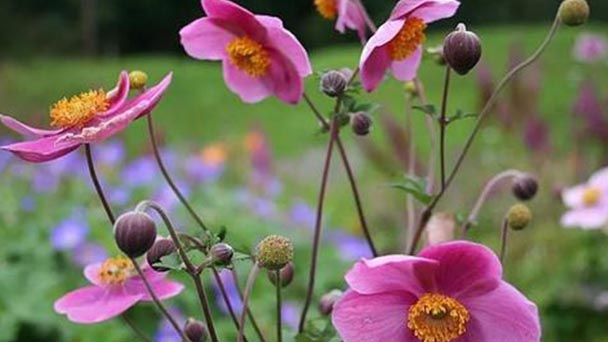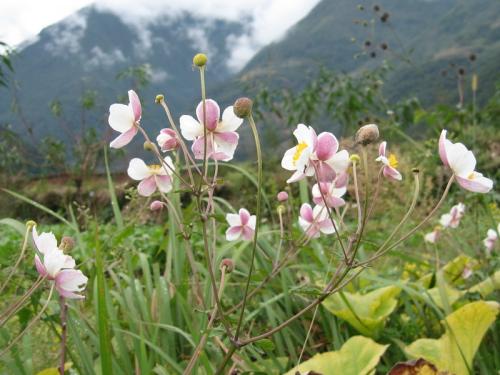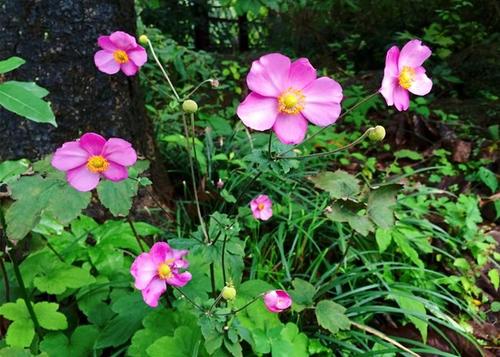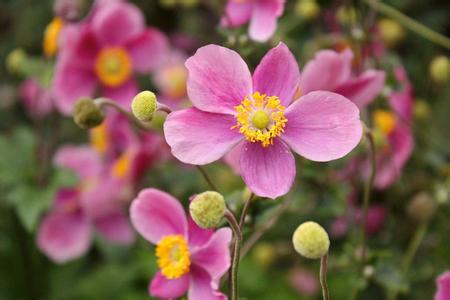Japanese anemone profile
Written by Maggie
Jan 07 2021

Japanese anemone, scientific name Eriocapitella hupehensis, is a perennial evergreen herb with large yellow and white flowers and distinctive split petals, often of high ornamental value.

The plant form of a Japanese anemone
Japanese anemone (Eriocapitella hupehensis) stems are thin, prostrate, and slender. The basal is leaf blade oblong, 2-3 (-5.5) cm long and 1-2.5 cm wide, apically rounded, base halbiform, upper leaf blade 3-lobed, middle lobes oblong or oblong-lanceolate, lateral lobes sub triangular, entire or 2-3 lobed, base of leaf blade cordate-shaped or halbiform;Petiole 1-5 cm long.
Flowers are axillary, 1-flowered, pedicels longer than petiole, apiculate; Bracts are broadly ovate, 0.8-1.6 cm long, apically obtuse or acute to acuminate; Sepals are oblong, 0.6-1 cm long, apically obtuse, mucronate, inner sepals slightly shorter.
Japanese anemone (Eriocapitella hupehensis) corolla is lavender or reddish, campanulate, 2 -- 4 cm long, corolla sub truncate or lobed; Stamens are subequal, filaments enlarged at base, adnate at base of corolla tube, covered with small scales; The ovary is glabrous, stigma 2-lobed, lobes oblong, flat.
The growth habits of Japanese anemone
Japanese anemone (Eriocapitella hupehensis) is a perennial evergreen herb. Potted plants should be placed in half sunshine place maintenance, often water, to prevent drought.

The main value of Japanese anemone
Japanese anemone flowers are large, yellow-white, terminal or 3-flowered in a cyme; Pedicels are slender, ca. 1cm; Bracts and bracteoles are linear-lanceolate; Japanese anemone has 5 calyx sepals, lanceolate, apex long acuminate, green or yellow-green. Japanese anemone is a very distinctive split flower.
Medicines: Japanese anemone whole grass can be used as medicine. Function: rheumatic swelling and pain, sequelae of poliomyelitis, scabies. General usage for decoction warm wash, not for internal consumption. Japanese anemone is poisonous. It should be taken internally under the guidance of a doctor.
Efficacy and effect and contraindication of Japanese anemone
It can be used for clearing heat and dampness, regulating qi and killing insects. The taste is bitter and cold.
Japanese anemone is highly effective in clearing away heat and dampness, and in treating a variety of stubborn tinea and other diseases. Because seeds do not live very long, the method of reproduction is usually to sow seeds when they are mature. Japanese anemone can be toxic, so it should be taken under a doctor's advice. It should not be taken by pregnant women.
Japanese anemone flower language
Innocence

Latest Updated
- Benefits of Bugleweed - 7 Science-backed Health Benefits
- Bugleweed Dangers & Side Effects - Is It Poisonous?
- How to Plant Evergreen Trees - What You Should Know
- When to Plant Evergreens - Grow Guide for Evergreen Trees
- 12 Wonderful Evergreen Shrubs for Your Garden
- 12 Popular Evergreen Plants with Pictures for Beginners
- When And How To Prune A Lilac Bush Like a Pro
- How to Grow & Care for Lilac Vine (Hardenbergia Violacea)
- Japanese Lilac Tree (Syringa Reticulata) Care & Propagation Guide
- Shumard Oak Pros and Cons - What to Know
Popular Articles
- Winter maintenance of Antirrhinum Majus
- How to Grow Terminalia Mantaly Tree
- How to Grow and Care for Crossostephium Chinense
- How to grow Antirrhinum Majus in spring
- Peristeria Elata (Dove Orchid) Profile: Info & Care Guide
- Underwatered Snake Plant (Sansevieria Trifasciata) - Signs And How To Fix
- How to Care for Brazilian Jasmine Plant (Mandevilla Sanderi)
- How to Grow & Care for Graptopetalum Purple Delight in Summer
- Rosa Chinensis (China Rose): Plant Growing & Care Tips
- How to Care for Baby Sun Rose (Aptenia Cordifolia)